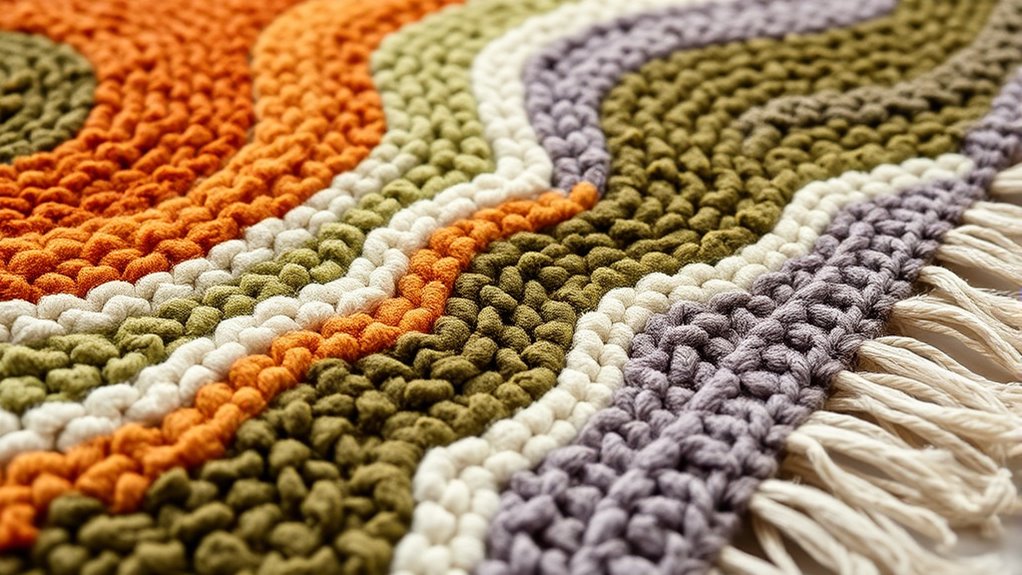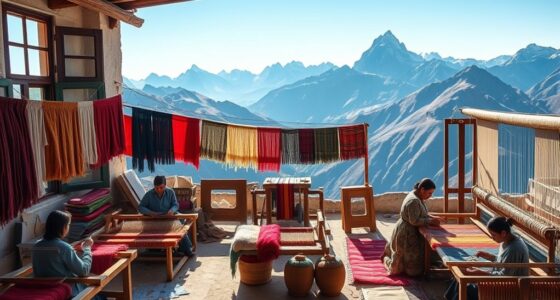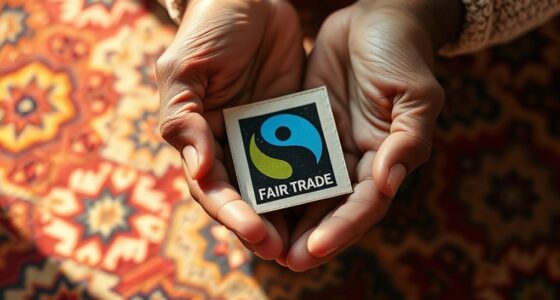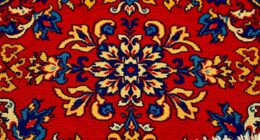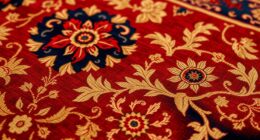In 2025, vegetable-dye palettes in rugs focus on natural earth tones like ochre, terracotta, and moss green, highlighting eco-friendly and authentic craftsmanship. Expect vibrant plant-based reds, oranges, and purples that make bold statements, alongside subtle gradients adding depth and elegance. These trends blend traditional techniques with modern aesthetics, emphasizing sustainability and eco-conscious practices. To discover how these colors are shaping contemporary rug design, keep exploring the fascinating world of vegetable dyes.
Key Takeaways
- Expect a resurgence of earthy, muted tones like ochre, moss green, and terracotta emphasizing natural materials and sustainability.
- Bright, vibrant vegetable dyes such as rich reds, oranges, and purples will dominate for bold statement rugs.
- Subtle gradient transitions and layered shades will enhance depth, texture, and visual interest in rug designs.
- Traditional botanical dye techniques will blend seamlessly with modern aesthetics, emphasizing authenticity and cultural symbolism.
- Eco-friendly vegetable dyes will lead the trend, prioritizing sustainability, reduced chemical use, and preservation of artisanal craftsmanship.
Embracing Natural Hues: The Return of Earth Tones
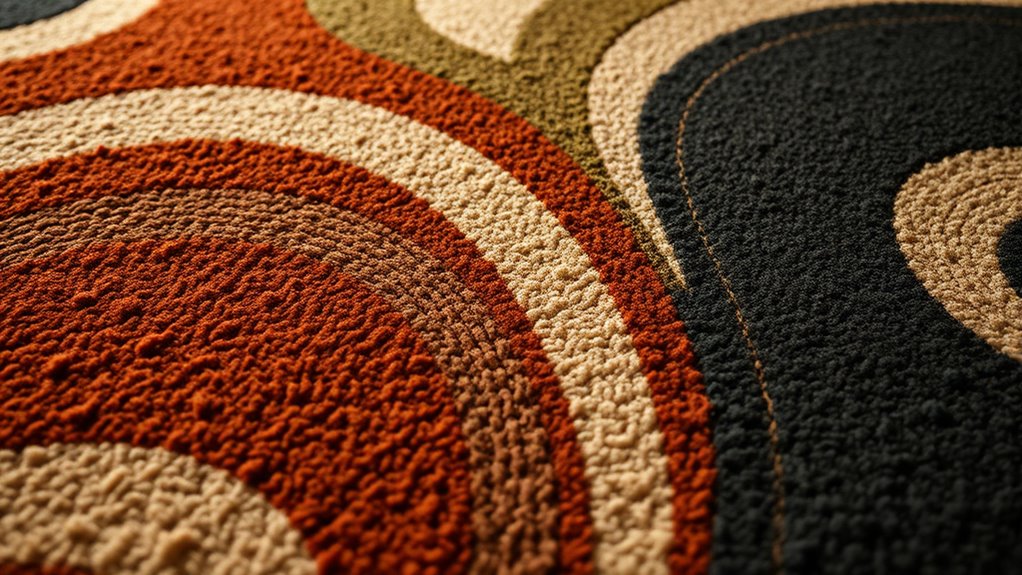
As designers and artists increasingly turn to sustainability, earth tones are making a strong comeback. You’ll notice a shift away from synthetic pigments and chemical dyes toward natural, vegetable-based hues that evoke warmth and authenticity. These earthy shades—think ochre, terracotta, and moss green—highlight the beauty of organic materials and reflect a commitment to eco-friendly practices. By choosing vegetable dyes over synthetic pigments, you reduce environmental impact and create more authentic, timeless designs. This movement emphasizes the importance of sustainable sourcing and craftsmanship, allowing you to craft pieces that resonate with nature’s simplicity. Incorporating sustainable sourcing and recycled products into planters and other design elements further enhances eco-friendly efforts. As a result, earth tones are no longer just a trend but a statement of conscious creativity in the world of rug design.
Bold and Bright: Vibrant Vegetable Dyes Making a Statement
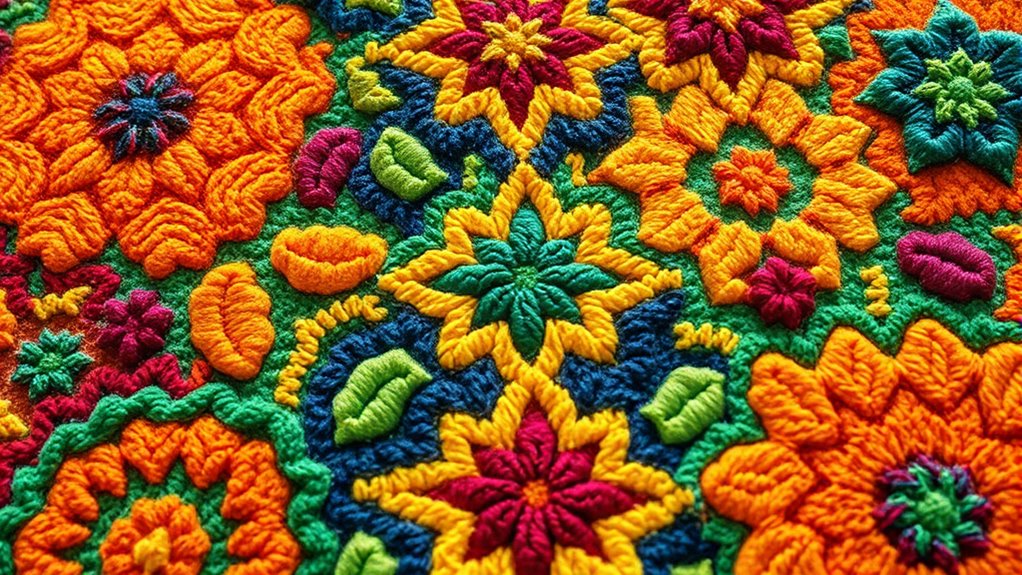
While earth tones emphasize the natural and subtle side of vegetable dyes, the vibrant spectrum showcases their bold potential. Using plant-based extraction methods, artisans can achieve striking, luminous colors that stand out. These vibrant vegetable dyes aren’t just eye-catching—they also boast impressive colorfast properties, ensuring your rug retains its brilliance over time. Thanks to advances in dyeing techniques, you can enjoy rich reds, bright oranges, and vivid purples that make a statement in any space. This bold approach allows you to embrace the natural origins of vegetable dyes while pushing creative boundaries. Incorporating natural materials and traditional methods enhances the authenticity and sustainability of the final product. Whether you want a fiery centerpiece or a lively accent, these vibrant vegetable dyes give you the power to create rugs that are both beautiful and durable.
Subtle Gradients and Layered Shades in Rug Design
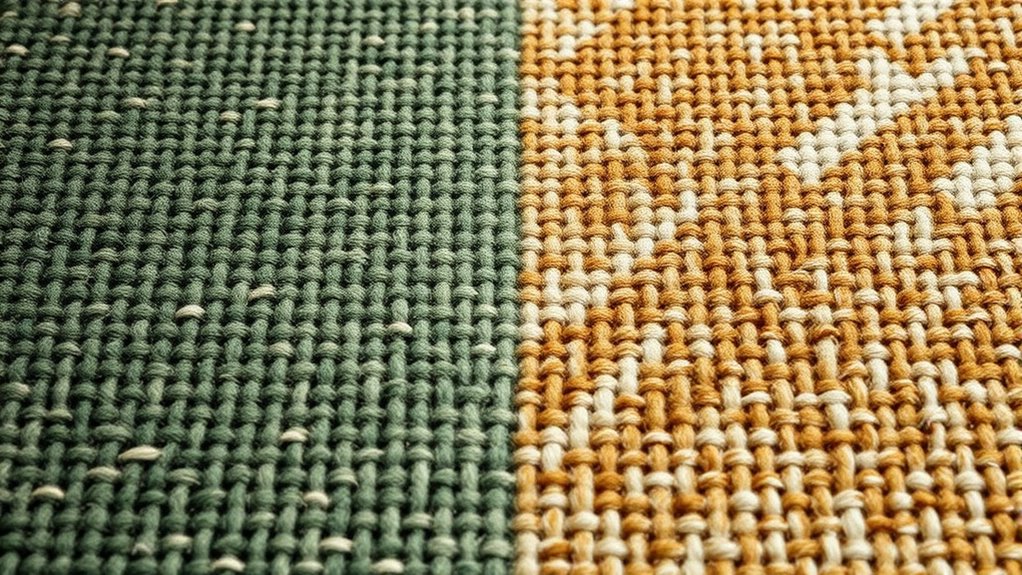
Subtle gradients and layered shades bring depth and nuance to vegetable-dyed rugs, creating a sophisticated visual effect. You’ll notice how color blending occurs seamlessly, giving the rug a nuanced, almost painterly quality. Shade passage becomes smoother, allowing different hues to flow into each other naturally. This technique enhances the rug’s texture and adds visual interest without overwhelming the design. Instead of stark contrasts, you see a gentle evolution of tones that evoke tranquility and elegance. Layered shades build complexity, encouraging your eye to explore the subtle shifts and gradients. This approach emphasizes craftsmanship and tradition, while still feeling fresh and contemporary. As you examine these rugs, you’ll appreciate how these delicate color transitions elevate the overall aesthetic, making each piece uniquely captivating. Incorporating mindful organization techniques can help maintain the beauty and integrity of these intricate designs over time, ensuring their durability and longevity. Understanding color theory principles can also deepen your appreciation of how these gradients contribute to the overall harmony of the design, revealing the artistic mastery involved in their creation. Additionally, exploring traditional dyeing methods can provide further insight into the rich cultural heritage behind these techniques.
Harmonizing Tradition and Modernity With Botanical Palettes
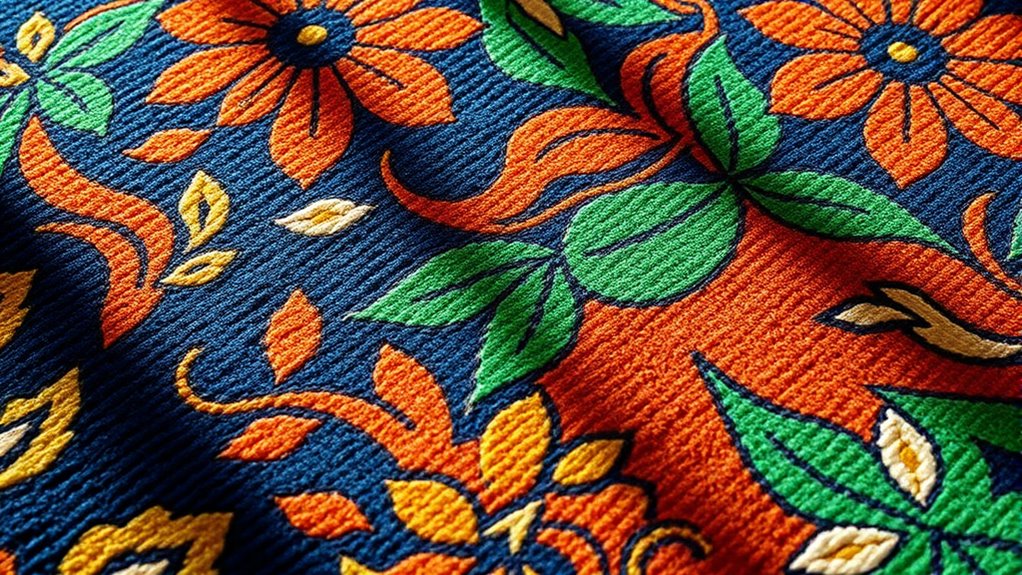
Botanical palettes seamlessly blend age-old tradition with contemporary design, allowing you to appreciate the natural beauty of plant-derived colors in modern contexts. By incorporating cultural symbolism, these colors carry meaning rooted in history, enriching your rug’s story. Traditional dye techniques, passed down through generations, lend authenticity and depth to these palettes, creating a bridge between the past and present. You’ll notice how earthy greens, vibrant reds, and subtle yellows evoke cultural identities and historical craftsmanship. This harmony enables you to enjoy modern aesthetics without losing sight of tradition. The use of natural dyeing methods ensures sustainability and preserves the environmental benefits associated with botanical color sources. Additionally, sustainable practices in dyeing contribute to ecological preservation and support environmentally conscious production. Implementing traditional techniques enhances the authenticity and unique character of each piece, connecting artisans’ skills with modern design sensibilities. The result is a balanced fusion, where timeless methods and symbolic hues come together to produce visually stunning, meaningful designs that resonate with both heritage and innovation.
Sustainable Craftsmanship: The Growing Popularity of Eco-Friendly Dyes

As awareness of environmental impact grows, more artisans and designers are turning to eco-friendly dyes to craft their textiles. You’ll notice a shift away from chemical processing, which often relies on harmful substances, toward natural, vegetable-based dyes. These eco-friendly alternatives reduce pollution and health risks while maintaining vibrant colors. By choosing vegetable dyes over synthetic options, you contribute to sustainable craftsmanship that respects both the environment and traditional techniques. This movement also encourages the preservation of traditional dyeing techniques, ensuring that cultural heritage is maintained alongside modern sustainability efforts. As the demand for sustainable practices increases, incorporating vegetable dyes becomes essential for modern rug-making. Embracing these natural dyes not only supports eco-friendly initiatives but also adds unique, authentic character to your creations.
Frequently Asked Questions
How Do Vegetable Dyes Compare to Synthetic Dyes in Durability?
When comparing vegetable dyes to synthetic dyes, you’ll find that vegetable dyes often have natural colorfastness but may lack the dye stability of synthetics. While vegetable dyes provide rich, earthy tones, they can fade faster with exposure to sunlight or washing. Synthetic dyes generally offer better durability and long-lasting vibrancy, making them more suitable if you want a rug that maintains its color over time.
Are Vegetable Dyes Suitable for All Types of Rug Fibers?
You might wonder if vegetable dyes suit all rug fibers. Generally, vegetable dyes work well with natural fibers like wool, cotton, and silk because of their good dye absorption and fiber compatibility. However, synthetic fibers like polyester or nylon often don’t absorb these dyes as effectively, which can lead to less vibrant colors or uneven results. So, always consider fiber compatibility to make certain your rug achieves the desired look and durability with vegetable dyes.
What Are the Cost Implications of Using Vegetable Dyes?
When considering the cost implications of using vegetable dyes, you’ll want to do a thorough cost analysis. While vegetable dyes can be more eco-friendly and unique, sourcing challenges may increase expenses due to limited suppliers and longer processing times. These factors can lead to higher material costs and potentially affect production timelines. Ultimately, weighing the environmental benefits against these costs helps you decide if vegetable dyes fit your budget and values.
How Do Vegetable Dyes Influence Rug Maintenance and Cleaning?
You’ll find that vegetable dyes require gentle cleaning, as they’re more prone to natural fading over time. Regular vacuuming helps maintain their vibrant colors, while spot cleaning with mild solutions prevents stains from setting. Though they’re less stain-resistant than synthetic dyes, proper care preserves their beauty. You might notice some fading, but with careful maintenance, your rug stays attractive and durable for years to come.
Can Vegetable Dyes Achieve the Same Color Vibrancy as Chemical Dyes?
Imagine a sunset spilling across your rug’s surface, your eyes craving that vivid glow. While vegetable dyes may not always match chemical dyes’ immediate vibrancy, they offer natural color richness and botanical pigment longevity. Over time, they deepen and develop, much like a fine wine. So, with patience, vegetable dyes can achieve stunning, lasting hues, enchanting your space with the warm, authentic beauty of nature’s palette.
Conclusion
As you explore the 2025 rug trends, remember that beauty lies in nature’s simplicity and boldness alike. Embrace earthy tones, vibrant hues, and layered shades to create a space that speaks your style. Sustainable dyes highlight your commitment to the planet, blending tradition with innovation. As the saying goes, “Beauty is in the eye of the beholder,” so trust your instincts and let these botanical palettes inspire your unique expression.
